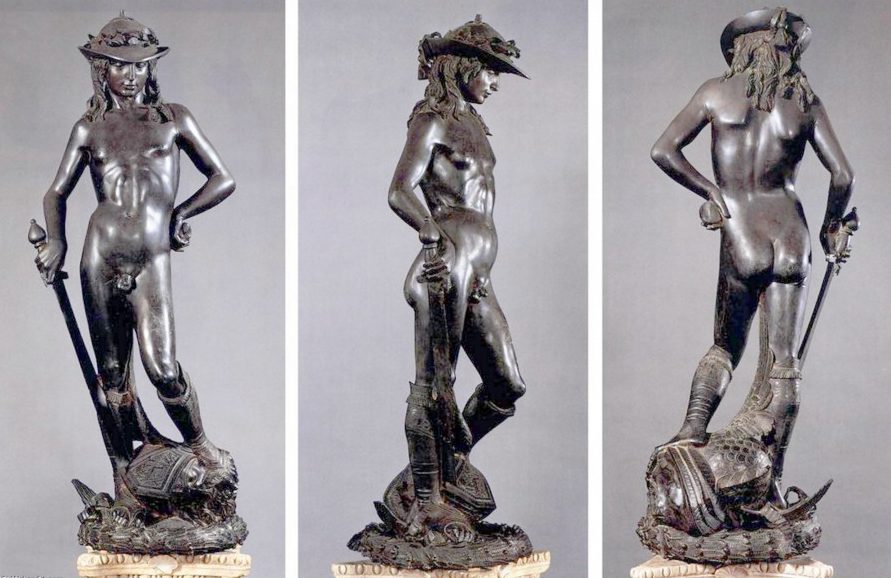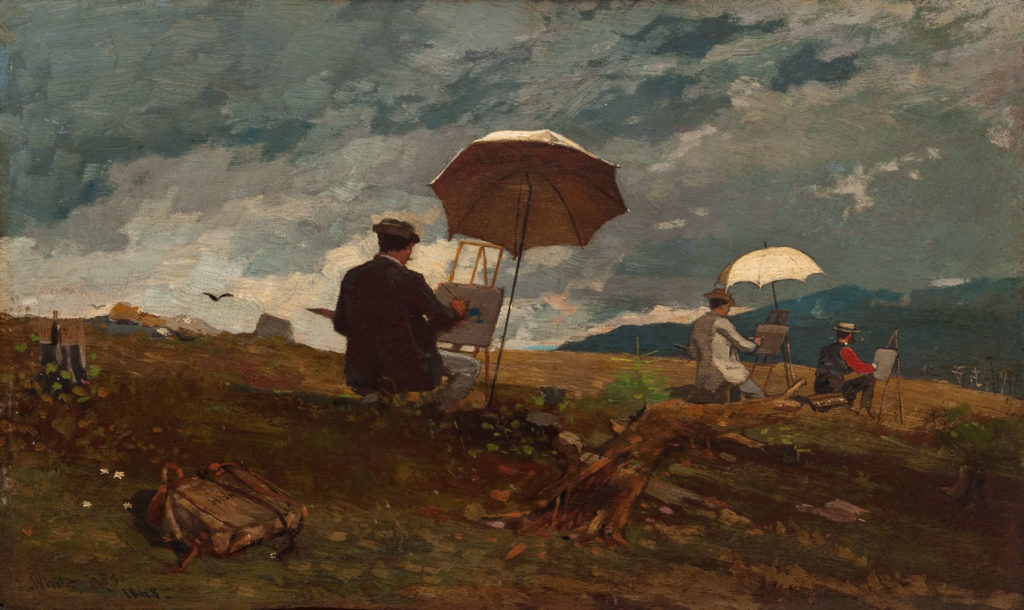31 Art Terms to Know for Describing (Your) Art

An Art History Glossary for Artists
Any visual artist knows they don’t have to say a word when it comes to describing their art. Sure, let the art speak for itself. But it doesn’t hurt to have a glossary of art terms that could be applied to any given piece of art. That’s why we’ve compiled an art history glossary of must-know vocab to use when describing art. It will come in handy when you are at the museum or watching the latest art documentary, or describing your own paintings and drawings.
Abstraction
Also known as nonrepresentational or nonobjective art. The heyday of abstraction was the early 20th century and artists who employ abstraction pull visual forms away from the “real” world through simplification, stylization or distillation of forms. Abstraction’s language is the language of color, texture, gesture, line and scale to name a few. Artists like Jackson Pollock typified the Abstract Expressionist art movement.

Unsplash
Alla prima
An Italian term directly translated as “at first attempt” but in the art world is known as an oil painting technique in which the artist paints in one go or wet-into-wet. The technique requires the artist to work fast and decisively before the surface paint dries. Also called direct painting and results tend to be described as bold, expressive and painterly.
Allegory
In literature, an allegory is an extended metaphor in which abstract ideas, often relating to moral or political meaning, are conveyed through language and storytelling. In art, an allegory is conveyed through imagery and that imagery takes on symbolic meaning. For example, Sandro Botticelli’s Primavera is an allegorical painting about the oncoming of Spring and passage of time. Interestingly, many artists including Jan Vermeer and Artemisia Gentileschi have painted allegories of painting, extended metaphors on the nature, preoccupations and influencers of artists and their work.
Appropriation
The act of taking, in this case, works by another artist and putting them into a new context. Usually this is done without the permission of person the original idea came from. It results in recontextualizing the “old” work and the creation of a “new” art piece. Artists and lawyers dispute where the line of permissible appropriation is drawn but usually complete appropriation is looked down upon while quoting or riffing off a work is acceptable in the art world and goes back for centuries.
Avant-garde
A French term that means “advance guard.” It’s a term that can be applied to artists and artworks as well as art movements as a whole. It is usually a stand-in phrase for art that is experimental, unusual, and forward-thinking.
Brushwork
If you are looking at a painting, likely you are looking at an object made with the use of a brush. There is a variety of brush techniques artists have used and evolved over the centuries in order to handle and apply paint including scumbling, dragging, and stippling among others. It also refers to the size, shape and texture of the strokes.
Chiaroscuro
An Italian term that means “light-dark” and is usually applied when there is a strong, dramatic contrast of light and dark in a painting or drawing. Artists use chiaroscuro to create a convincing sense of volume and dimensionality in their work. Photography can be described with the term but it harkens back originally to Renaissances and the works of Caravaggio, Rembrandt and Leonardo da Vinci.

Crucifixion of St. Peter by Caravaggio
Color Theory
Artists for centuries have organized, reorganized and made rules around color perception and color mixing. In present day, students of art are taught about the color wheel; primary, secondary and tertiary colors; and color relationships or the visual effects of color combinations.
Composition
The term broadly applied to how the elements of an artwork are arranged. Certain strategies for composition have been around for hundreds of years like the Golden Mean and the Rule of Thirds.
Contrapposto
An Italian term that means counterpoise and describes when a human figure’s weight is balanced more on one leg than the other, resulting in shoulders and arms off-axis to hips and legs. The stance is most famous in sculpture and goes back to the classical ages.

The contrapposto of Donatellos bronze David clearly displayed in these three views of the sculpture.
Distortion
In painting and drawing, distortion means changing the visual appearance of a figure or object — pulling, twisting, stretching and changing something for expressive purpose.
Figurative Art
Usually this is a term mostly applied to paintings or sculptures. Specifically, it means the work is representational, in contrast to abstract art.
Genre
A term with a confusing backstory in the visual arts. Historically it meant a painting of a person or people in everyday situations who were simply not identified. But it also encompasses still life painting, animal painting, and landscape and marine painting.
Glazing
Early Masters such as Rembrandt applied multiple layers of transparent paint to produce the deep, glowing hues and darks that came to typify their work, according to author Michael Wilcox of the bestselling painting techniques book, Glazing. According to Wilcox, darks seethed with hidden color. The range of rich hues employed by these earlier painters gave a mysterious depth and intensity to their work, a richness and luminosity that only the glazing techniques can give.
Impressionism
Impressionism was the 19th century art movement known for artists who produced paintings that were of everyday scenes, painted with small but visible brushstrokes, with an emphasis on the accurate depiction of light and its changeable nature.

Impression, soleil levant by Claude Monet
Mixed media
An artwork in which more than one medium or material has been incorporated is described as mixed media. Assemblage and collage are popular mixed media art forms.
Motif
A motif is an element, pattern or design in an artwork that is often used repeatedly. An artist can also use a motif again and again in a body of work and even throughout their career.
Narrative
In essence, narrative is visual storytelling. In painting and drawing, images are static so artists over time have come up with strategies to deal with that reality, from depicting single scenes of a story to multiple scenes (in which characters appear more than once) or a panoramic, in which multiple events take place in a single scene.
Perspective
There are two main types of perspective strategies to make two-dimensional forms look three dimensional. Linear perspective conveys the illusion of space with receding parallel lines meeting at a vanishing point. Atmospheric perspective addresses distance by changing color tones and the level of detail employed to paint or draw an object.
Photorealism
The genre or artistic movement that encompasses painting and drawing that reproduce images as realistically as possible. This is also the term for a group of American artists who painted in just such a way in the 1960s and 1970s including Chuck Close.
Plein air
The act of painting outdoors in the city or landscape as opposed creating art in a studio. It is a French term and most relevant to the work of the artists of the Barbizon School, Hudson River School and the Impressionists. Today, many contemporary artists identify themselves as plein air painters, artists who paint mostly or exclusively outdoors.

Artists Sketching in the White Mountains by Winslow Homer
Proportion
The relationship to the size between one element and another or between an element and an entire work. To make an artwork that is more realistic, certain proportion ranges have to be met and have been codified, which means there are rules out there (going all the way back to Durer) that an artist can learn. Playing with or altering proportions allows an artist to veer away from realism into more expressive territory.
Realism
Often called naturalism as well. Generally speaking, this is the attempt of a visual artist to attempt to depict people, places, and objects realistically. This means avoiding stylization and artificiality.
Scale
The size of objects or depicted objects as they relate to one another. Size impacts meaning and expression. Artists will use scale to convey importance or significance. Consider miniatures in contrast to life-size to over life-size objects.
Sfumato
A painting technique that describes the soft transition between colors. The Mona Lisa, arguably the most famous painting of all time, is a key example of sfumato, which derives from the Italian word for smoke. Leonardo da Vinci described it as: “without lines or borders, in the manner of smoke or beyond the focus plane.” In English, it has come to mean softened or blurred edges and lines when applied to artworks.
Symbolism
Symbols can be personal but historically they refer to broadly accepted and understood references. In painting or drawing, this is applied to visual references, usually objects that stand in for ideas or meanings. Symbols can be religious, political or cultural. Some contemporary artists operate only within the bounds of symbols that they often times create themselves — their own visual languages as it were. When an artwork is all or mostly about the conversation that takes place between symbols, the result is an allegory.
Texture
In painting, there are so many ways texture can and has been manipulated. Historic European artists created paintings with glassy, texture-less surfaces. Modern painters embraced texture, whether allowing paint to seep into a surface or build up onto it. Impasto is the process or technique of thickly applying paint to a surface.
Theme
An overall idea that an artwork or body of work conveys. An artist can convey a theme in many ways — with symbolism, with scale and proportion, with formal aspects of their pursuit like color, line and texture.
Trompe l’oeil
The treachery of images indeed! This is a French term for “deceiving the eye” and is applied to the painting techniques employed to create an optical illusion of reality, using perspective techniques and devices like breaking the picture plane–so an object looks like it is jutting out of the surface of a painting.

The Treachery of Images by René Magritte
Underpainting
The painting technique of creating a monochromatic version of an image and then allowing it to dry. Then an artist uses transparent and semitransparent layers of paint known as glazes to continue the painting, all the while allowing parts of the underpainting to peek through, increasing the illusion of depth a painting has.
Value
The lightness or darkness of a color or hue. Many artists argue value is the most important aspect of a realistic painting — more important than color itself.
[block id=”351758″]
















This is the right blog for anyone who wants to know about Historical Art. The article is good and it is pleasant to read. I have known very important things here. Thank you very much for this post.
So true! And if you ever have any questions about terminology — just let me know! I can always add to this! lol!
So glad you liked the article. I loved writing it!
love this article.
like taking a college class.
so much info.
thank you.
i enjoy all the interesting info you send us and sometimes i print it out and file it for reference.
B. Collins
Great info for a new self taught artist like myself!!